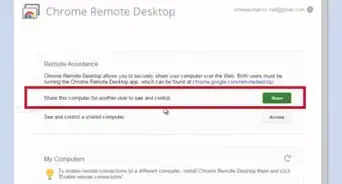This article was co-authored by Clinton M. Sandvick, JD, PhD. Clinton M. Sandvick worked as a civil litigator in California for over 7 years. He received his JD from the University of Wisconsin-Madison in 1998 and his PhD in American History from the University of Oregon in 2013.
There are 19 references cited in this article, which can be found at the bottom of the page.
This article has been viewed 42,787 times.
One of the fundamental rights of workers in the United States is the right to form or join a labor union. A labor union is a group of workers who work collectively to advance their interests and to bargain for wages, benefits, workplace-safety rules, and other matters. There are over 60 unions throughout the country that represent over 14 million workers in a wide array of industries and professions.[1] The average weekly income of unionized workers is higher than that of non-unionized workers.[2]
Steps
Joining an Existing Union in the Workplace
-
1Learn about the workplace union. If your workplace has a union, it negotiates collective bargaining agreements that cover benefits and wages for all employees in a bargaining unit. A bargaining unit is a group of employees who perform similar work. Generally, the union is the sole negotiator for all employees in the unit, even those not in the union.
- Unions also represent members in workplace disputes with supervisors.[3] Common disputes occur around discipline and termination. A union may pay for a lawyer to help the employee arbitrate a dispute.[4]
- Ask around and talk to a co-worker who is in the union. Ask if she or he has ever had to file a complaint with the union and how it was resolved.
- Also ask if they think they are getting good value for the dues they are paying.
-
2Call Human Resources (HR). If your workplace has a union already in place, then you should call Human Resources to ask how to join. Alternately, you could ask a co-worker if she knows who the union representative at your workplace is.
- Whether or not HR has a form depends on whether the collective bargaining agreement provides for HR to deduct union dues. If the agreement does not, then contact your union representative.
Advertisement -
3Ask for a form. Get the “Dues Withholding Form” from HR or from your union representative. You will need to include personal information (name, address, and job title). You will also need to provide your Social Security Number so that union dues can be deducted from your paycheck.[5]
- Make sure you have the right form. Multiple unions are often present at large employers (such as universities). Some unions may exist for hourly workers and a separate union may exist for salaried workers. Each has its own form.
- A typical form looks like this.
-
4Understand how much you will pay in dues. Union membership isn't free. You will have to pay dues on a schedule, typically monthly. There should be a dues schedule that HR can give you.
- The amount of union dues varies by workplace. Generally, you can expect to pay between $200 and several hundred dollars a year.[6]
- Union dues fund a variety of activities, for example office support and organizing costs. Money is also used to pay fees for attorneys who help with negotiations and accountants who analyze the employer’s finances.[7]
- You are probably already paying into a union. Although a unionized workplace will be open to employees who do not join, bargaining agreements often require all workers to pay a percentage of the union dues.[8] This is called an “agency fee.”
-
5Complete the form and submit. Complete the form accurately and completely. Unless you request that your application be withdrawn, you should be enrolled automatically in the union.
- Keep a copy for your records.
-
6Pay your union dues. If HR automatically deducts your dues, then you do not have to do anything to pay your dues. However, if HR does not automatically deduct dues, then you will be responsible for paying them yourself.
- Each union has different methods of payments. Some require that you send the money to a designated delegate. The delegate then sends back stamps for you to paste into a booklet, signaling that you paid your dues.
- Other unions require you to pay online.[9] You will be given an identification number and password. Once you log-in, you can then pay the dues.
- Be sure to ask your union representative about how to pay, and contact her with any questions.
-
7Participate in the union. Active participation is crucial to a successful union. You may vote on issues and in elections, as well as join committees. Committees are commonly formed around education, consumer affairs, veterans, and women’s issues.
Forming a Union in the Workplace
-
1Learn about the benefits of a union. A union engages in “collective bargaining.” That is, it negotiates wages and benefits for all members of the bargaining unit.[10] On average, unionized workplaces provide higher wages and greater benefits than non-unionized ones.[11]
- Other benefits may be just as important. For example, collective bargaining agreements can limit termination to “just cause” only.[12] The contract will then define what qualifies as “just cause” and will also provide procedures for contesting the termination, such as arbitration.
- Collective bargaining agreements also can provide job protection for workers based on seniority. Collective bargaining agreements can stipulate that, in the event of layoffs, those who were hired last should be fired first.
-
2Research unions. If there is not a union already present in your workplace, then you should search for national unions in your industry that you could join. You will need to organize the workers in your workplace, and national unions like the Service Employees International Union or the United Food Commercial Workers union will have resources and staff who can help you.
- Search on the web for “union” and then your industry, such as “food preparer” or “call center customer service rep.”
- Also contact your state or local labor council, who may be able to point you in the right direction.
- Belonging to a national union is beneficial as the national union has more resources and experience in collective bargaining. If no national union exists, you can still go ahead with your union drive. The process is largely the same.
-
3Learn the 3 ways to form unions. Under federal law there are 3 ways to form unions.
- 1) 30% of people sign cards, then there will be a NLRB verified election or
- 2) Card check- If over 50% of the eligibles sign a card then the employer can waive the secret election and begin negotiating with the union.
- 3) If 50% sign a card and the NLRB finds that the employer is engaging in behavior that will make a fair election impossible then the NLRB can mandate the creation of a union.
-
4Talk to co-workers. Before you can organize your workplace, you should talk to your co-workers about any problems they are having: low wages, unsafe working conditions, poor vacation policies, etc.[13]
- Find out if your co-workers share your same concerns. Do they have additional concerns, such as an overall lack of dignity or respect?
- Be sure to talk only on breaks and away from the workplace. It is not illegal to discuss forming a union, but management can derail the organizing drive much easier if they catch wind of it early in the process.[14]
- Your employer cannot retaliate for your concerted activity to improve wages or working conditions.[15] So long as you are working to improve the conditions for yourself and other employees, your discussing the formation of a union is legally protected.
-
5Form a committee. Identify those individuals who share a common set of core concerns. Ideally, the committee should be representative of the workplace in terms of age, gender, and race.[16]
- Aim for a committee that is about 10% of the workforce.[17]
- Once you have a committee, you can meet with a union organizer from the national union you are trying to join. The organizer will help you learn the ins and outs of labor law and help develop a plan for organizing the workplace.
- The specifics of the organizing plan will differ by workplace. But you will first need to “map out” your workplace by identifying who works where and with whom.[18] You will then work to identify which issues matter the most to which workers.[19] You will target your union drive to workers based on their concerns.
- The organizer can also help the committee come up with ways to counter management’s arguments against the union.
-
6Recruit co-workers. Now that the committee has been formed, committee members should reach out to the remaining co-workers and discuss the key issues they are worried about. Listen respectfully to people's concerns and ideas.
- At this point, management will likely hear of the union and begin to discourage workers from joining.
- Consider drafting a petition that lays out the core issues the union is being formed to address. Ask workers if they would like to sign it.[20]
- Remind co-workers that it is against the law for management to retaliate for union organizing.[21]
-
7Hold a card check drive. Once the committee believes that it has majority support, you should hold a card check drive. During this process, employees will be given cards to sign, indicating that they want to join the union. If a majority of employees sign the cards, then you can approach management and ask that the union be recognized.
- A sample card looks like this. You will get cards from the umbrella union (such as the UAW or the AFL-CIO).
- Management may choose to recognize the union if a majority of employees sign a card. However, management can also require that an election be held, and this is the option most companies choose.[22]
Running an Election
-
1Get National Labor Relations Board (NLRB) forms. If your employer refuses to recognize a union, then the only other option is to be certified through an NLRB election. You will start the process by getting the RC Petition, Form NLRB-502 and the Certificate of Service, NLRB-5544.
-
2Serve notice on the employer. You must give your employer a copy of the RC petition, as well as a blank Statement of Petition Form, NLRB-505, and a copy of the Description of Procedures in Certification and Decertification Cases, NLRB-4812.
- Print them off and either hand deliver or mail.
- Do not share with your employer the cards that were signed.[24]
-
3Submit documents to the NLRB. Submit the completed RC petition and the Certificate of Service to the NLRB. Also send in your “showing of interest,” which means the checked cards.[25]
- All documents may be mailed to the regional NLRB office where the employer is located. To find the correct office, visit here and click on the map.
- You shouldn’t have to wait more than 5-8 weeks after notifying the NLRB to hear back from them.
-
4Anticipate your employer's campaign. If the National Labor Relations Board holds an election, then management will likely intensify its campaign to keep a union out of the workplace. You should anticipate, and formulate rebuttals to, the following arguments:[26]
- A union will force the employer to lay off workers.
- Union dues will be extremely high.
- The employer deserves another chance to improve the working conditions without a union present.
-
5Participate in the election. The NLRB will run an election. If a majority of workers who vote in the election select the union, then management must recognize the union.[27]
- Your employer must post information about the election in conspicuous places around the workplace.[28]
- If you believe that your employer at any time has tried to influence the vote by threatening discipline or demotion, or has promised promotions or raises, then you should notify the regional NLRB office.
References
- ↑ http://www.unionplus.org/about/labor-unions
- ↑ http://www.bankrate.com/finance/personal-finance/pros-cons-union-jobs-1.aspx
- ↑ http://www.workplacefairness.org/labor-unions#23
- ↑ https://www.afge.org/index.cfm?page=representation
- ↑ https://www.opm.gov/forms/pdf_fill/sf1187.pdf
- ↑ http://www.bankrate.com/finance/personal-finance/pros-cons-union-jobs-2.aspx
- ↑ http://teamster.org/about/frequently-asked-questions-faq#faq05
- ↑ http://www.nrtw.org/a/a_1_p.htm
- ↑ http://www.iwlocal1.com/union_dues_pay_online.html
- ↑ https://aflcio.org/what-unions-do/empower-workers/collective-bargaining
- ↑ https://aflcio.org/what-unions-do
- ↑ http://www.bankrate.com/finance/personal-finance/pros-cons-union-jobs-2.aspx
- ↑ http://www.cwa-union.org/pages/how_to_organize_a_union
- ↑ http://www.cwa-union.org/pages/how_to_organize_a_union
- ↑ https://www.nlrb.gov/about-nlrb/rights-we-protect/the-law/employees/concerted-activity
- ↑ http://www.ueunion.org/org_steps.html
- ↑ http://www.cwa-union.org/pages/how_to_organize_a_union
- ↑ http://www.ufcw1189.org/node/524
- ↑ http://www.ufcw1189.org/node/524
- ↑ http://www.cwa-union.org/pages/how_to_organize_a_union
- ↑ http://www.workplacefairness.org/unions-retaliation#1
- ↑ http://www.flaflcio.org/?q=getaunion
- ↑ http://www.nlrb.gov/what-we-do/conduct-elections
- ↑ https://www.nlrb.gov/sites/default/files/attachments/basic-page/node-3040/Form%20NLRB-502%20(RC)%20-%20RC%20Petition.pdf
- ↑ https://www.nlrb.gov/sites/default/files/attachments/basic-page/node-3040/Form%20NLRB-502%20(RC)%20-%20RC%20Petition.pdf
- ↑ http://www.cwa-union.org/pages/how_to_organize_a_union
- ↑ http://www.cwa-union.org/pages/how_to_organize_a_union
- ↑ http://www.nlrb.gov/what-we-do/conduct-elections














































































